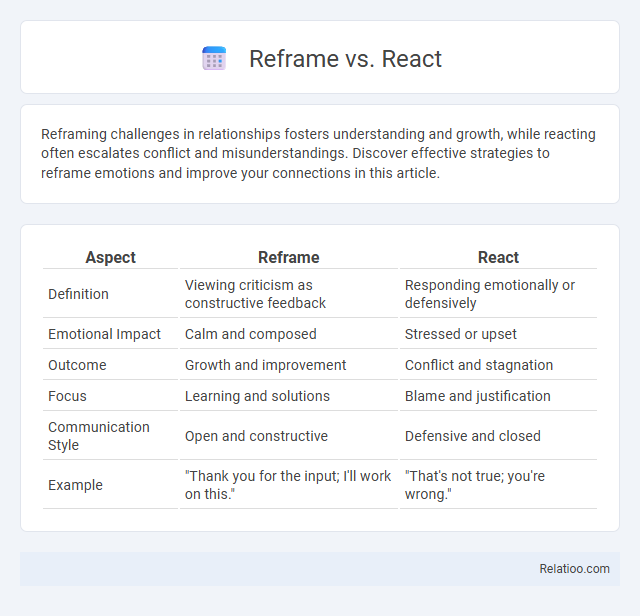Reframing challenges in relationships fosters understanding and growth, while reacting often escalates conflict and misunderstandings. Discover effective strategies to reframe emotions and improve your connections in this article.
Table of Comparison
| Aspect | Reframe | React |
|---|---|---|
| Definition | Viewing criticism as constructive feedback | Responding emotionally or defensively |
| Emotional Impact | Calm and composed | Stressed or upset |
| Outcome | Growth and improvement | Conflict and stagnation |
| Focus | Learning and solutions | Blame and justification |
| Communication Style | Open and constructive | Defensive and closed |
| Example | "Thank you for the input; I'll work on this." | "That's not true; you're wrong." |
Understanding Reframing and Reacting
Understanding reframing involves shifting your perspective to interpret situations more positively or constructively, which can lead to improved emotional resilience and problem-solving skills. Reacting, by contrast, often triggers immediate, impulsive responses based on emotion rather than thoughtful consideration. Mastering reframing helps you replace unproductive reactions with deliberate, empowering viewpoints that enhance decision-making and communication.
The Psychology Behind Reframe vs React
The psychology behind Reframe vs React lies in how your brain processes emotional triggers and cognitive control. Reacting often stems from the amygdala's fight-or-flight response, leading to impulsive decisions without rational assessment. Reframing activates the prefrontal cortex, allowing you to reinterpret events positively and manage stress effectively by reshaping your perception and emotional response.
Key Differences: Reframing vs Reacting
Reframing involves consciously changing the perspective on a situation to find new meaning or opportunities, while reacting typically entails an immediate, emotional response without thoughtful analysis. Reframing encourages cognitive flexibility and emotional regulation, leading to proactive problem-solving and reduced stress. In contrast, reacting often results in impulsive decisions and heightened emotional turmoil, limiting constructive outcomes.
Benefits of Reframing Over Reacting
Reframing your thoughts allows you to shift perspectives, transforming challenges into opportunities for growth, unlike reacting impulsively which often escalates stress and conflict. This cognitive approach enhances emotional regulation, improves decision-making, and fosters resilience in difficult situations. By choosing to reframe, you empower your mind to respond with clarity and balance, promoting long-term mental well-being.
Common Triggers for Reacting Instinctively
Common triggers for reacting instinctively include perceived threats, emotional stress, and unexpected challenges that activate the brain's amygdala, leading to impulsive responses. Reframing involves consciously shifting perspective to reinterpret these triggers as opportunities for growth or problem-solving rather than threats. This cognitive shift empowers individuals to respond thoughtfully, reducing reactive behavior and promoting emotional resilience.
Techniques to Practice Reframing
Techniques to practice reframing include cognitive restructuring, where negative thoughts are identified and replaced with positive or neutral alternatives, enhancing emotional regulation. Visualization exercises help individuals imagine alternative outcomes or perspectives, promoting flexibility in interpreting situations. Mindfulness practices increase awareness of automatic reactions, enabling conscious choice in how to respond rather than react impulsively.
Real-Life Examples: Reframe vs React
Reframe involves consciously shifting your perspective to interpret a situation more positively, such as viewing a job loss as an opportunity for career growth, while React triggers immediate emotional responses like frustration or anger. In real-life scenarios, reframing helps you manage stress by altering your mindset, whereas reacting impulsively can escalate conflicts or hinder problem-solving. Your ability to reframe challenges empowers you to navigate difficulties with resilience and clarity.
Overcoming Challenges in Changing Your Response
Reframe, React, and Reframe represent a powerful strategy for overcoming challenges in changing your response to difficult situations. You respond initially with a reactive mindset, then consciously reframe your perspective to identify new opportunities or solutions. This process empowers emotional regulation and resilience, enhancing your ability to adapt and thrive under pressure.
The Impact on Relationships: Reframe vs React
Reframing your perspective during conflicts fosters empathy and understanding, promoting healthier communication patterns in relationships. Reacting impulsively often escalates tensions, leading to misunderstandings and weakened bonds. Your ability to reframe situations can transform challenges into opportunities for connection and growth.
Building a Habit of Reframing for Personal Growth
Building a habit of reframing involves consistently shifting perspectives to view challenges as opportunities for growth, which enhances emotional resilience and problem-solving skills. Unlike reacting impulsively to situations, reframing encourages thoughtful responses that promote positive mindset shifts and long-term personal development. Developing this skill supports mental flexibility, reduces stress, and fosters continuous self-improvement by transforming negative thoughts into constructive insights.

Infographic: Reframe vs React
 relatioo.com
relatioo.com